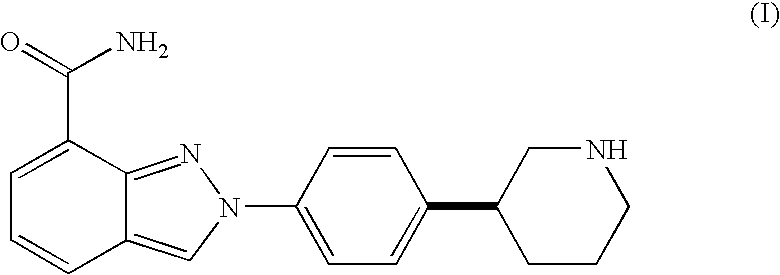Pharmaceutically acceptable salts of 2--2h-indazole-7-carboxamide
a technology of indazole and salts, which is applied in the field of pharmaceutically acceptable salts of 2- 2hindazole7carboxamide, can solve the problems of cell death, major cause of tissue damage, severe depletion of nadsup>+/sup>,
- Summary
- Abstract
- Description
- Claims
- Application Information
AI Technical Summary
Problems solved by technology
Method used
Image
Examples
example a
2-Phenyl-2H-indazole-7-carboxamide (A6)
Step 1: Methyl 3-methyl-2-nitrobenzoate (A1)
[0212]To a suspension of 3-methyl-2-nitro-benzoic acid (1.0 eq.) in MeOH (0.4 M) at 0° C. was added dropwise AcCl (3.0 eq.). The reaction mixture was stirred for 20 hr at reflux. The solvent was reduced in vacuo and the residue was dissolved in EtOAc and washed several times with sat. aq. NaHCO3 solution, brine and dried (Na2SO4). Evaporation of the solvent gave (A1) as a white solid which was used in the next step without further purification. 1H NMR (400 MHz, CDCl3, 300K) δ 7.86 (1H, d, J=7.5 Hz), 7.53-7.42 (2H, m), 3.89 (3H, s), 2.36 (3H, s). MS (ES) C9H9NO4 requires: 195, found: 218 (M+Na)+.
Step 2: Methyl 3-(bromomethyl)-2-nitrobenzoate (A2)
[0213]A mixture of (A1) (1.0 eq.), (BzO)2 (0.06 eq.) and NBS (1.18 eq.) in CCl4 (0.2 M, with respect to A1) was heated at reflux under N2 atmosphere for 12 hr. The mixture was cooled to RT, diluted with DCM, concentrated under reduced pressure whilst dry loadin...
example b
3-{4-[7-(Aminocarbonyl)-2H-indazol-2-yl]phenyl}piperidinium chloride (B4)
Step 1: tert-Butyl 3-[4-({-[3-(methoxycarbonyl)-2-nitrophenyl]methylene}amino) phenyl]piperidine-1-carboxylate (B1)
[0218](B1) was prepared following the general procedure reported for Example A step 4 using A3 and tert-butyl 3-(4-aminophenyl)piperidine-1-carboxylate until TLC revealed completation of the reaction (Petroleum ether:EtOAc=4:1) and was used in the next step without further purification.
Step 2: Methyl 2-{4-[1-(tert-butoxycarbonyl)piperidin-3-yl]phenyl}-2H-indazole-7-carboxylate (B2)
[0219](B2) was prepared following the general procedure reported for Example A step 5 and the crude was purified by flash column cromatography on silica using a gradient of 20-40% EtOAc / Petroleum ether to yield the desired (B2) as a yellow solid. 1H NMR (400 MHz, CDCl3, 300K) δ 8.51 (1H, s), 8.13 (1H, d, J=7.1 Hz), 7.95 (1H, d, J=8.3 Hz), 7.91 (2H, d, J=8.4 Hz), 7.39 (2H, d, J=8.4 Hz), 7.18 (1H, t, J=7.2 Hz), 4.30-4.10 (2...
example c
2-{4-[(3R)-Piperidin-3-yl]phenyl}-2H-indazole-7-carboxamide (C1) & 2-{4[(3S)-Piperidin-3-yl]phenyl}-2H-indazole-7-carboxamide (C2)
[0222]Example B, B4 was separated by chiral SFC (column: Chiralpak AS-H, 1×25 mm, flow: 10 ml / min, Tcol: 35° C., Pcol: 100 bar, modifier: 55% (iPrOH+4% Et2NH)), using CO2 as supercritic eluent, affording both pure enantiomers.
[0223]The first eluted enantiomer (C1), retention time (SFC): 4.80 min, was obtained as a white powder. 1H NMR (400 MHz, DMSO-d6, 300K) δ 9.28 (s, 1H), 8.57 (br. s, 1H), 8.06 (d, 2H, J=7.2 Hz), 8.04 (d, 2H, J=8.4 Hz), 7.88 (br. s, 1H), 7.49 (d, 2H, J=8.4 Hz), 7.27 (dd, 1H, J=8.4, 7.2 Hz), 3.08-2.94 (m, 2H), 2.77-2.67 (m, 1H), 2.64-2.52 (m, 1H), 1.98-1.90 (m, 1H), 1.75-1.47 (m, 4H). MS (ES) C19H20N4O requires: 320, found: 321 (M+H)+. The free base was converted to (3R)-3-{4-[7-(aminocarbonyl)-2H-indazol-2-yl]phenyl}piperidinium chloride and the optical rotation measured: [α]20D=+133.3 (c 0.15, MeOH).
[0224]The second eluted enantiomer ...
PUM
| Property | Measurement | Unit |
|---|---|---|
| Electrical conductance | aaaaa | aaaaa |
Abstract
Description
Claims
Application Information
 Login to View More
Login to View More - R&D
- Intellectual Property
- Life Sciences
- Materials
- Tech Scout
- Unparalleled Data Quality
- Higher Quality Content
- 60% Fewer Hallucinations
Browse by: Latest US Patents, China's latest patents, Technical Efficacy Thesaurus, Application Domain, Technology Topic, Popular Technical Reports.
© 2025 PatSnap. All rights reserved.Legal|Privacy policy|Modern Slavery Act Transparency Statement|Sitemap|About US| Contact US: help@patsnap.com

